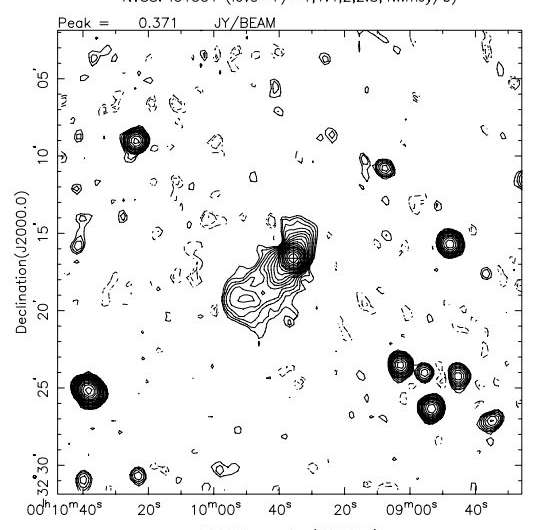October 17, 2018 report
Researchers investigate the peculiar radio source IC 1531

An international team of researchers has investigated a peculiar extragalactic radio source known as IC 1531. The new study analyzes the nature of IC 1531's high-energy emission, suggesting that the source is a radio galaxy. The findings are presented in a paper published October 5 on arXiv.org.
Extragalactic radio sources represent some of the most unusual, extreme and energetic physical processes in the universe. They exhibit unique morphology and could offer important clues into the evolution of galaxies and groups of galaxies. Such sources usually turn out to be radio galaxies, quasars or blazars, emitting strong radio waves.
Located around 350 million light-years away from the Earth, IC 1531 (also designated PKS 0007-325) is an extragalactic radio source associated with the gamma-ray object 3FGL J0009.9−3206. Although IC 1531 is present in various astronomical surveys and catalogs, it has not been thoroughly studied yet.
Based on observations conducted by the Large Area Telescope (LAT) onboard NASA's Fermi gamma-ray spacecraft, IC 1531 was classified as a blazar of uncertain type. Now, a new study led by Tiziana Bassi of the Institute of Space Astrophysics and Cosmic Physics of Palermo, Italy, has investigated high-energy emission of IC 1531 and assessed the classification of this source.
The new study is an analysis of observations of this object carried out using various ground-based telescopes and spacecraft, including the Karl G. Jansky Very Large Array (VLA), ESA's XMM-Newton mission, as well as NASA's Chandra and Swift space observatories.
"We present a multi-wavelength study of IC 1531 (z=0.02564), an extragalactic radio source associated with the γ-ray object 3FGL J0009.9−3206 and classified as a blazar of uncertain type in the Third Fermi Large Area Telescope AGN [active galactic nuclei] Catalog (3LAC)," the researchers wrote in the paper.
According to the study, IC 1531 showcases a core-jet structure, visible in radio and X-rays, which is enclosed within a wide radio structure of about 717,000 light-years. The research found that radio and X-ray brightness of the large-scale radio structure is decreasing moving out of the core, and the X-ray spectrum of the jet is compatible with synchrotron emissions.
The astronomers noted that the observed morphology of IC 1531 suggests that the source is a low-power Fanaroff-Riley type I (FR I) radio galaxy, showing a moderate Doppler boosted flux amplification.
"Its large-scale radio and X-ray morphologies and different diagnostic methods in the optical to infrared bands suggest that the source is likely a FR I radio galaxy whose jet is seen at moderate inclination angles," the paper reads.
The authors of the paper added that IC 1531 could be a valuable target of observations for astronomers studying sources at the boundaries between radio galaxies and blazars. Such objects, studied using large-field, sky-surveying observatories, could be helpful in probing the existence of multiple sites of production of the most energetic emission in the jets.
More information: T. Bassi et al, Faint γ-ray sources at low-redshift: the radio galaxy IC 1531. arXiv:1810.02668 [astro-ph.HE] arxiv.org/abs/1810.02668
© 2018 Phys.org




















